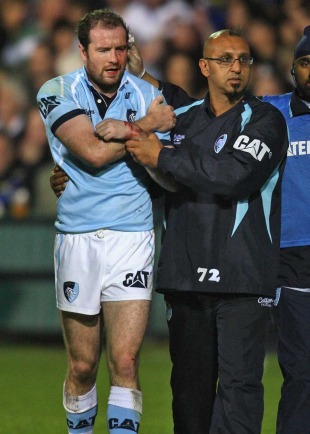|
English Rugby
Premiership reveals drop in injuries
ESPNscrum Staff
February 14, 2011

Leicester's Geordan Murphy is forced to leave the field during his side's Premiership clash with Bath during the 2009-10 season
© Getty Images
Enlarge
English rugby's key stakeholders have welcomed the results of the annual injury audit that reveal there was a drop in the number injuries during the 2009-10 Premiership season. The survey, conducted by Premiership Rugby, the Rugby Players' Association and the Rugby Football Union every year since 2003, shows that there was a 20% reduction in the likelihood of a player sustaining an injury during the 2009-10 compared with the previous season. There was also a drop in the severity of each injury with the average lay-off falling from 23 days to 22 days and as a result a commensurate reduction in the total number of days players were absent due to injury of 26%. The data is contained in the seventh England Rugby Premiership Training & Injury Audit 2009-10 presented and accepted by the Professional Game Board last month and follows last year's report that revealed an increase in both the likelihood of a match injury and the length of time an injury kept a player out. Dr. Simon Kemp, RFU Head of Sports Medicine and Chair of the England Rugby Premiership Injury and Training Audit Steering Group praised the work of medical staff. "There was a reduction in the severity of injuries across all categories and a marked reduction in the recurrence of match injuries," he said. "That suggests a more complete and effective rehabilitation of all injuries by club and England medics." England manager Martin Johnson was also buoyed by the results, adding, "Investment in the injury audit has been crucial, providing the game in England with a robust, clinical programme of research that allows the kind of accurate assessment of the injury risk involved in training for and playing elite rugby union that no other country can replicate." Phil Winstanley, Rugby Director at Premiership Rugby, the umbrella body representing English rugby's leading clubs, added, "The reduction in injury rates shown in the latest audit is encouraging, however the value is in the ongoing analysis of data and the changes that can inform. "The injury audit is the main part of what is a much wider programme of medical initiatives taking place in England designed to promote the safest playing and training environment in world rugby. Cardiac screening, the illicit drugs education programme, the alcohol education programme, pitch side trauma care and concussion management are all examples of what is happening at the elite level in England and an example of what can be achieved when clubs, players and the union work together." Bath prop David Barnes, Chairman of the Rugby Players' Association, was also keen to see player welfare remains central to those governing the game. "It's important now to remain vigilant and sustain the levels of research that will improve our understanding of the causes and nature of rugby injuries. Using this knowledge and working to ensure best practice continues to be present and consistent in all club and international teams will enable us to continue this downward trend in rates of injury." Data was gathered from all registered Premiership Rugby players and covered training and playing in all the major competitions. Data was also gathered from the elite England team, but due to the relatively low number of matches played, the main body of the audit is based on data gathered from the Premiership Rugby clubs.
Key findings:
+ The likelihood of sustaining an injury dropped from 100 injuries per 1,000 hours in 2008-9 to 80 injuries per 1,000 hours in 2009-10 + Small decrease in the number of knee Anterior Cruciate Ligament (ACL) injuries, which had significantly affected the figures in 2008-9, but injuries fell across all levels of severity + Reduced likelihood and reduced severity meant that the average days' absence per club, per match, fell from 46 days in 2008-9 to 34 days in 2009-10, a reduction of 26% + Largest drop seen in the incidence of recurrence of injury. Days absence per 1,000 hours due to recurrence of an injury dropped from 485 in 2008-9 to 207 in 2009-10, a decrease of 43% and reported as "a marker of the completeness of rehabilitation by Premiership Rugby and England medical and conditioning staff and a very encouraging trend" © ESPN Sports Media Ltd.
|
Live Sports
Communication error please reload the page.
-
Football
-
Cricket
-
Rugby
-
- Days
- Hrs
- Mins
- Secs
F1 - Abu Dhabi GP
Abu Dhabi Grand Prix December 11-131. Max Verstappen ()
2. Valtteri Bottas (Mercedes)
3. Lewis Hamilton (Mercedes)
4. Alexander Albon ()
5. Lando Norris ()
6. Carlos Sainz Jr ()
-
ESPNOtherLive >>
Darts - Premier League
Golf - Houston Open
Snooker - China Open
Tennis - Miami Open

